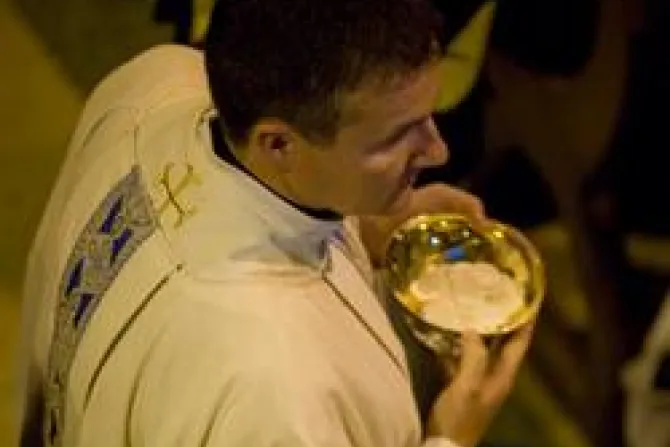Phoenix, Ariz., Sep 29, 2011 / 01:08 am
The new General Instruction of the Roman Missal allows more freedom for bishops to determine norms for the distribution of communion under both forms within their diocese, said liturgist Fr. John Muir.
“The bottom line is that Communion under both kinds is allowed whenever the bishop thinks appropriate--be those instances few or many,” Fr. Muir told CNA on Sept. 28.
On Sept. 21, the Diocese of Phoenix announced that it plans to adopt the updated norms for communion, allowing the chalice to be offered to the faithful in three instances, or on other solemnities as determined by a parish priest.
The diocese issued a statement explaining that the new norms “will promote unity in the celebration of the Eucharist all around the world.”
While it acknowledged that communion under both forms has become common in some areas of America, the diocese also noted that “the vast majority of the parishes throughout the world have not had communion under both forms.”
For the last 25 years, the Church in the United States, the United Kingdom and Oceania have been granted special privileges to experiment with communion under both forms. As a result, the practice of receiving both forms has become common in certain regions.
However, these privileges expired when the Vatican did not renew them in 2005. The guidelines for liturgical practice around the world are currently established by the Third Edition of the General Instruction of the Roman Missal, which was released in June 2011.
Fr. Muir explained that the updated General Instruction gives bishops across the country the freedom to differ in the way that they establish norms within their dioceses.
He observed that the General Instruction states that “the diocesan bishop may lay down norms for the distribution of communion under both kinds for his own diocese.”
Previously, he explained, only the local Conference of Bishops could grant permission for the distribution of communion under both forms beyond the 14 instances listed in the General Instruction.
Now, he said, the General Instruction has reduced that number to three instances, and individual bishops “now have more freedom to clarify and extend those instances for both kinds than they previously enjoyed.”
According to the new guidelines, the bishop “is given the faculty to permit communion under both kinds whenever it may seem appropriate to the priest to whom a community has been entrusted as its own shepherd, provided that the faithful have been well instructed and that there is no danger of profanation of the Sacrament.”
“There seems to be significant room for how bishops go about the practical work of offering these concrete permissions and norms,” Fr. Muir explained.
“Perhaps some parishes will offer the chalice less frequently, perhaps some will offer it more.”
The Diocese of Phoenix is anticipating a decree from Bishop Olmsted clarifying the additional circumstances for communion under both kinds not listed in the General Instruction, he added.
Fr. Muir acknowledged that the practice of receiving communion under both species has become common in many parts of the United States.
(Story continues below)
“Explaining this change will require a lot of patience and charity,” he said.
He explained that some Catholics may “believe that reception from the chalice is necessary for true Holy Communion with our Eucharistic Lord,” while others “have simply grown accustomed to both species at every single Mass.”
In some instances, he observed, others “may have unfortunately burdened Communion under both kinds with ideological, political, or other agenda.”
But anyone who thinks that communion under both forms “was an attempt to share ‘power’ between clergy and lay faithful” is simply looking at the change through “the wrong lens,” he said.
“The central dogmatic point is that the faithful receive Christ whole and entire under only one species of Holy Communion,” he said, explaining that both the reception of communion under one species and under two species can be opportunities for understanding the Eucharist.
“One form reminds us of the one Christ received, whole and entire,” he said. “But reception of both species, at the proper times and circumstances, manifests the great reality received under one or both forms: Christ's body, blood, soul, and divinity, and all this in the context of a heavenly wedding feast.”
Fr. Muir also addressed the issue of parishes that violate liturgical norms.
“It is important to know exactly what both universal and diocesan norms are,” he said. Because bishops may determine norms for the distribution of Communion under both kinds in their diocese, the norms may differ among dioceses throughout the country.
“If however, there is a serious violation happening, the principal of subsidiarity is a practical help,” he said.
If a parishioner finds that his parish priest is consistently violating Church law, Fr. Muir said, he should speak privately to the priest. If the grievance is not addressed, he can then turn to the pastor, the dean, the diocesan office of worship, and finally to the local bishop.
In dealing with such violations, Fr. Muir emphasized the need to act “with charity and patience.”
“We must always act with great respect and love for both our sacred rites and for our sacred pastors,” he said.



